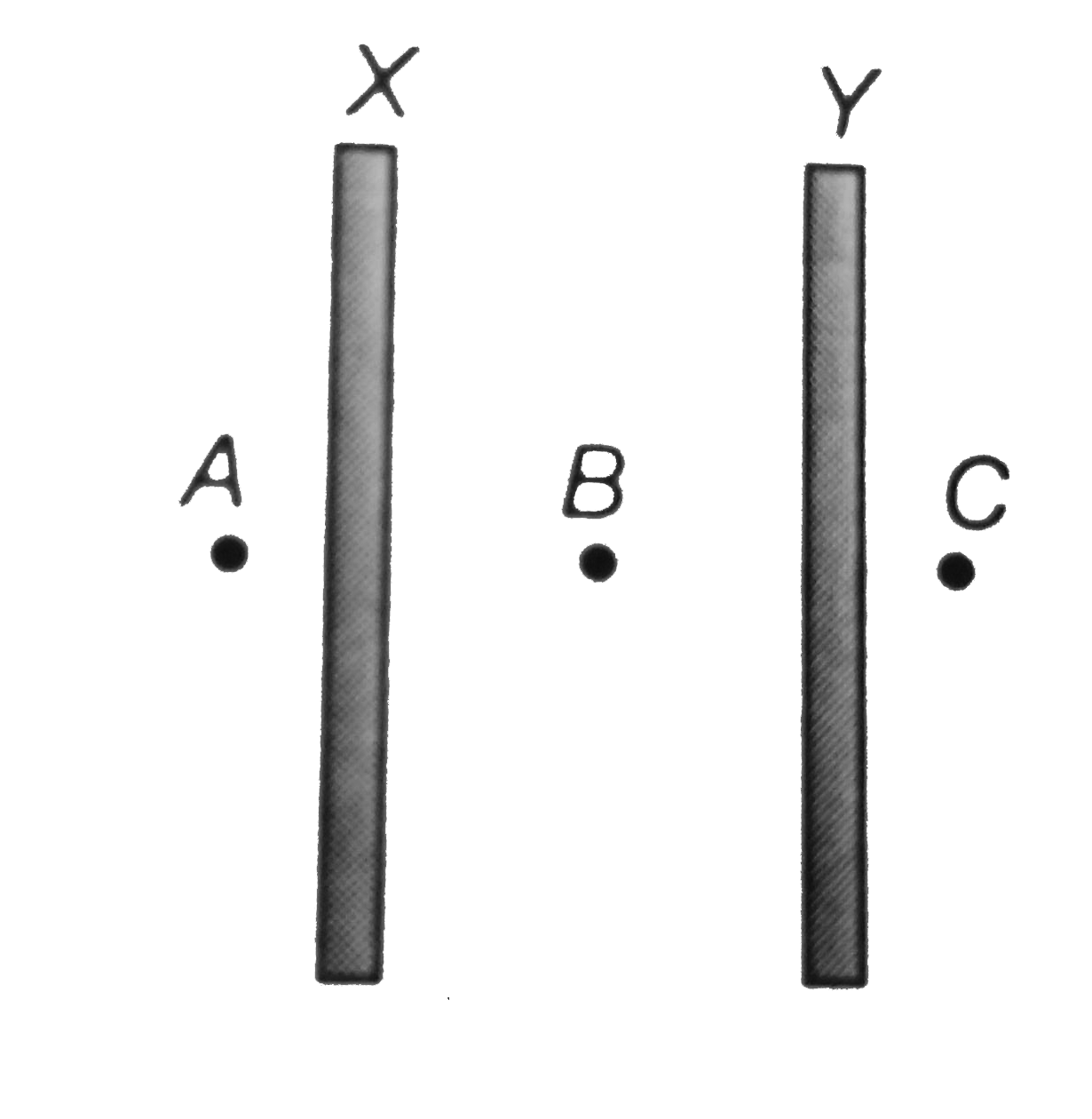There are two large conducting plane sheets. Both of them are given charges Q1 and Q2 . What is the charge distribution on their surfaces, when they are (i) large distance apart (ii) brought close and placed parallel to each other ?
(i) When they are at large distance from each other.

Electric field inside the conductor is zero. This is the case when both the surface have same surface charge density. Thus, the charge distributes equality on both sides.
(ii) When they are brought closer to each other, the electric field is the superposition field. But net field inside the conductor roust be zero. Let the cahrge distribution in the figure. Charge densities at different surface will be
σ1=Q1−q1A
σ2=q1A
σ3=q2A
σ4=Q2−q2A
Region I is inside a conductor , therefore E=0
⇒σ1−σ2−σ3−σ4ε0=0
⇒σ1=σ2+σ3+σ4 ....(i)

Similarly, for region III, E=0,
=σ4−σ1+σ2−σ3=0
or σ4=σ1+σ2+σ3 (ii)
From (i) and (ii)
σ2+σ3=0⇒q1=−q2
Also, σ1=σ4⇒Q1−q1=Q2−q2
Put q2=−q1⇒Q1−q1=Q2+q1
or, q1=Q1−Q22⇒q2=−(Q1−Q22)
Thus, the charge distribution is as shown

where q=Q1−Q22

Topper's Solved these Questions
- ELECTROSTATIC POTENTIAL AND CAPACITANCE BOOK - AAKASH INSTITUTECHAPTER - ELECTROSTATIC POTENTIAL AND CAPACITANCE EXERCISE - TRY YOURSELF
110 Videos
- ELECTROSTATIC POTENTIAL AND CAPACITANCE BOOK - AAKASH INSTITUTECHAPTER - ELECTROSTATIC POTENTIAL AND CAPACITANCE EXERCISE - ASSIGNMENT (SECTION-A) Objective Type Questions (Only one answer)
47 Videos
- ELECTROMAGNETIC WAVESBOOK - AAKASH INSTITUTECHAPTER - ELECTROMAGNETIC WAVESEXERCISE - ASSIGNMENT SECTION - D Assertion-Reason Type Questions
25 Videos
- GRAVITATION BOOK - AAKASH INSTITUTECHAPTER - GRAVITATION EXERCISE - ASSIGNMENT SECTION - D (ASSERTION-REASON TYPE QUESTIONS)
16 Videos
Similar Questions
Two large parallel conducting sheets (placed at finite distance) are given charges Q and 2Q respectively. Find out charges appearing on all the surfaces.

View SolutionTwo conducting plates A and B are placed parallel to each other. A is given a charge. Q1 and B a charge Q2. Find the distribution of charges on the four surface.
View Solution
Knowledge Check
Two conducting spheres of radii r1 and r2 having charges Q1 and Q2 respectively are connected to each other. There is
Ano change in the energy of the systemBan increase in the energy of the systemCalways a decrease in the energy of the systemDa decrease in the energy of the system unless Q1r2=Q2r1Each of two large conducting parallel plates has one sided surface area A. If one of the plates is given a charge Q whereas the other is neutral, then the electric field at a point in between the plates is given by
AQAε0BQ2Aε0CQ4Aε0DZeroX and Y are large, parallel conducting plates close to each other. Each face has an area A. X is given a charge Q. Y is without any charge. Points A,B and C are as shown in the figure.
 AThe field at B is Q2εABThe field at B is Qε0ACThe fiels at A,B and C are of the same magnitudeDThe fieds at A and C are of the same magnitude, but in opposite directions
AThe field at B is Q2εABThe field at B is Qε0ACThe fiels at A,B and C are of the same magnitudeDThe fieds at A and C are of the same magnitude, but in opposite directions
Two conducting plates A and B are placed parallel to each other. A is given a charge Q1 and B a charge Q2. Prove that the charges on the inner surfaces are of equal magnitude and opposite sign.
View SolutionThree parallel metalic plates each of area A are kept as shown in figure and charges q1,q2 and q3 are given to them. Find the resulting charge distribution on the six surfaces, neglecting edge effects as usual,

View SolutionTwo point charges, each of mass m and charge q are released when they are at a distance from each other. What is the speed of each charged particle when they are at a distance 2r ?
View SolutionTwo identical conducting balls A and B have charges -Q and +3Q respectively . They are brought in contact with each other and then separated by a distance d apart. Find the nature of the coulumb force between them.
View SolutionForce between two conducting large plates , with charges Q and Q2 as shown in the figure, is (Area of each face of plate =A)
_PHY_E01_022_Q01.png)
View Solution
